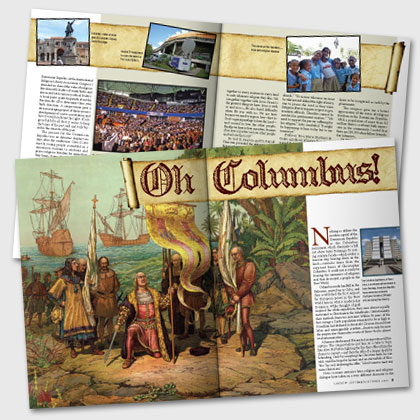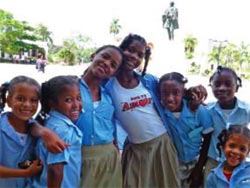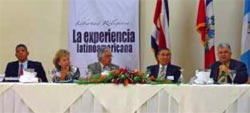Oh Columbus
Lincoln E. Steed September/October 2009
Nothing so defines the modern capital of the Dominican Republic as the Columbus monument, which dominates a hill just above Santo Domingo. Its soaring concrete facade—which evokes a massive ship bearing down on the land—contains more than the supposed bones of Christopher Columbus. It could just as easily be bearing the memories of religious zeal that destroyed a people in the New World.
Columbus made landfall in the Bahamas, moved on to Cuba, and then established the first outpost for European power in the New World here in what is modern-day Dominica. While thoughts of gold inspired the whole expedition, they were almost equally motivated to Christianize the inhabitants. Unfortunately, their methods knew no restraint. Within 50 years of the first voyage a Carib population estimated to be as high as 10 million had declined to about 400. Disease, forced slave labor, and unimaginable cruelties—known only because the perpetrators themselves wrote of them—led to almost total extermination.
A famous chief named Hatuey led an opposition till his capture. The conquistadores put him on a stake to burn him alive. But before lighting the fire they offered him the chance to convert—and then the offer of a cleaner death by beheading. Only by accepting the Christian faith, he was told, could he hope for heaven and an eternal life of bliss. “No,” he said, declining the offer, “I don’t want to meet any more Christians.”
Now, so many centuries later, religion and religious dialogue have taken on a very different character in the Dominican Republic. At the International Religious Liberty Association Congress I attended we shared the value of religious freedom with leaders of many faiths and interacted with various political leaders. A Jesuit priest spoke eloquently about the freedom for all to determine their own faith direction. A congressman gave a very encouraging report of the in-process development of a new constitution and how it would enshrine the rights of religious faith for all. Best, it seems, to keep the bones of the past well and truly buried in the concrete of the past.
The present for the Dominican Republic was on dynamic display two days after the conference. Over 13,000 mostly young people assembled in a downtown stadium to celebrate and praise religious freedom for more than four hours. It was a highly charged program that moved along with an energy seemingly derived from the frequently cheering thousands. I will never forget the moment when, to the accompaniment of a costumed chorus and musical soloist on the stage, a “cast of hundreds” in costume enacted the freedom story of the biblical exodus.
Also on stage was Moses and Pharaoh’s court. Down on the floor a multitude of Hebrew slaves surged through the parting waters of the Red Sea (a billowing vision of cloth held by more actors). On the stage a brazier next to Pharaoh flamed up as he spoke of never letting them go. But at that moment down on the floor someone lit a huge paper-wrapped column that literally became the pillar of fire leading them to freedom. Thank God for religious liberty. And the crowd cheered!
Liberty in the Land of Columbus
Religious Liberty Celebrated in Dominican Republic
The first Inter-American IRLA (International Religious Liberty Association) Congress was held in Santo Domingo, Dominican Republic, April 27-30, 2009. It was characterized by easy and open discussion between quite disparate groups.
Panel discussion included Rabbi Oisiki Ghiti, of the Jewish Community; Rev. Francisco Javier Colino, professor at the major Jesuit seminary; Pastor Braulio Portes, president of the Christianization Church in the Dominican Republic; and Obispo Cesar Holguin Kourry, of the Episcopal Church. All noted the positive changes in understanding of religious freedom in Latin America and the Caribbean.

They desire all the freedoms—especially religious freedom
“The human being is the foundation of our society with rights that nobody can destroy,” Rev. Colino, of the Roman Catholic Church, said to the delegates. “We need to allow the churches to work with liberty and freedom to share the true liberty God offers to men—to seek truth without pressure and violence. Religious institutions need to help society. Religious liberty is our human right—government cannot change its position on human rights. And if privileges are given to one religion we must have rights to everyone.”
Colino called upon everyone to work together in protecting religious liberty. However, everyone is guilty, he noted, of not doing more. “As religious leaders we need to respect the rights of everyone. . . . We need to be united and raise voices together to every creature in every land to seek whatever religion they like. We can gather together with Jesus. Peace is the greatest thing we have. Jesus is with us and in us—He also faced difficulty when He was with us. We are here because we need to express love—first to God—a great privilege to love the Lord—and second to love the other people. Finally, we have to love ourselves, because if we love ourselves we love other people and we love the Lord.”
Dr. Scot E. Isaacson and Dr. Patrick Thurston provided the delegates with a historical review of the experience of the Church of Jesus Christ of Latter-day Saints in Latin America. From humble missionary beginnings in the 1850s it is now a major religious movement in the region today. But there is a history of trial and perseverance against religious discrimination and persecution.
A consistent theme throughout the presentations was the recognition that religious freedom not only includes the right to practice one’s faith but it requires equal treatment among the religious communities. Examples were given of some Latin American countries that authorized only the majority religion’s clergy to perform marriages.
Dr. Israel Leito, president of the Inter-American Division of Seventh-day Adventists, reminded the delegates that there is still a ways to go in the region to protect religious freedom. He suggested that there is “intolerance without boundaries.” “In most of our countries they recognize just one church.” He bemoaned the fact that in some situations the government says where a church may be built—“In other countries the church building has to be smaller than the main church.” “To receive tolerance we must be tolerant and defend the right of everyone to praise the Lord as they want. Religious liberty requires respect to government officials. Churches cannot be involved in government matters.” “We need to support the person suffering for his religion,” Leito concluded. “It might be happening to him today but to me tomorrow.”
 Professor Rosa Maria Martínez de Codes, a professor of history from Spain, argued that government must reflect the changing reality in society. Latin America is very different today from 50 years ago when not every religion was accepted. Today there is a greater plurality that requires a change in views. The fact that the Roman Catholic Church enjoys privileges, she noted, “doesn’t mean the other religions should not be so recognized.” She warned that it will require much effort and gave the example of Spain. It took the Spanish government more than 10 years of negotiations with the religious communities to arrive at a comprehensive agreement of what would be required of a new religion in Spain to be recognized as such by the government.
Professor Rosa Maria Martínez de Codes, a professor of history from Spain, argued that government must reflect the changing reality in society. Latin America is very different today from 50 years ago when not every religion was accepted. Today there is a greater plurality that requires a change in views. The fact that the Roman Catholic Church enjoys privileges, she noted, “doesn’t mean the other religions should not be so recognized.” She warned that it will require much effort and gave the example of Spain. It took the Spanish government more than 10 years of negotiations with the religious communities to arrive at a comprehensive agreement of what would be required of a new religion in Spain to be recognized as such by the government.
The congress gave me a better appreciation of the status of religious freedom in the Dominican Republic. With a population of more than 9.2 million there is a vibrant faith expression in the community. I noted that there are 250,000 of my fellow Seventh-day Adventists.
On May 2, as a follow-up to the seminar, over 13,000 Dominicans showed up for the Festival of Religious Freedom. The program was very well organized and involved hundreds of young people who participated as members of choirs, bands, marching parades, and drama presentations.
“It is a great accomplishment,” noted Dr. John Graz, IRLA director, “for the Dominican Republic to have hosted this event. They have much to be proud of. The congress was very good and . . . the weekend festival was fabulous.”
Article Author: Lincoln E. Steed
Lincoln E. Steed is the editor of Liberty magazine, a 200,000 circulation religious liberty journal which is distributed to political leaders, judiciary, lawyers and other thought leaders in North America. He is additionally the host of the weekly 3ABN television show "The Liberty Insider," and the radio program "Lifequest Liberty."